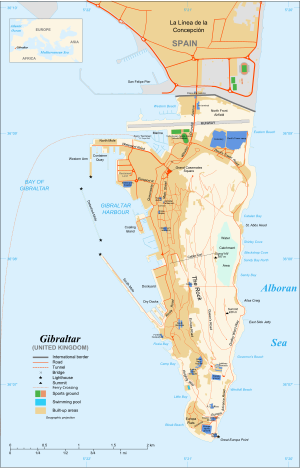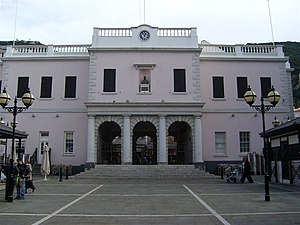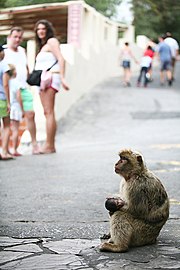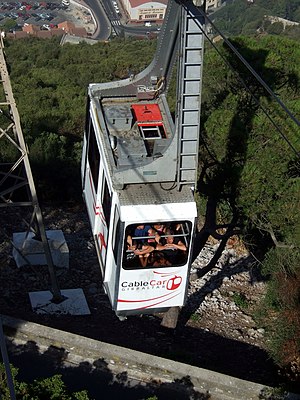Difference between revisions of "Gibraltar"
(→British Gibraltar) |
(→British Gibraltar) |
(No difference)
| |
Latest revision as of 14:35, 6 April 2020
| Gibraltar (British overseas territory) | |
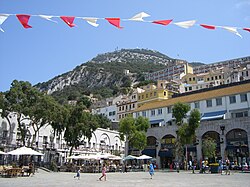 Grand Casemates Square | |
|---|---|
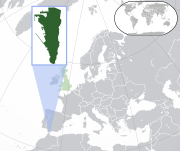
| |

| |
| Nulli Expugnabilis Hosti | |
| Area: | 2.6 sq miles |
| Population: | 29,431 (2009 est.) |
| Time zone: | GMT+1 |
| TLD: | .gi |
Gibraltar is a British overseas territory at the southern tip of the Iberian peninsula in south-western Europe at the entrance of the Mediterranean. It is a peninsula of 2.6 square miles connceted by a low-lying isthmus to the north with the European mainland. Its only land frontier is here, with Spain.
The Rock of Gibraltar is the major landmark of the region. At its foot is the densely populated city area, home to almost 30,000 Gibraltarians and other nationalities. The city now spreads out far beyond the Rock into lands reclaimed from the Bay of Gibraltar.
Gibraltar has been British territory since 1704 when it was captured by a joint English-Dutch force during the War of the Spanish Succession. Gibraltar was subsequently ceded to Britain by Spain under the Treaty of Utrecht in 1713. It became an important base for the British Royal Navy, which for most of the colony's history drove the local economy and provided employment for a large portion of the local population. Today the territory's economy is based largely on tourism, financial services and shipping
Contents
Name of Gibraltar
The name "Gibraltar" is the Spanish derivation of the Arabic name Jabal Tāriq (جبل طارق), meaning "mountain of Tariq". The name refers to the geological formation, the Rock of Gibraltar, which in turn was named apparently after the Berber Umayyad general Tariq ibn-Ziyad who led the initial incursion into Iberia in advance of the main Moorish force in 711 under the command of Umayyad Caliph Al-Walid I.
In classical times Gibraltar was known as Mons Calpe, one of the Pillars of Hercules. The first reference to Gibraltar in English is in King Alfred's translation of the History of Paulus Orosius, in which it is named Calpis.
Today, Gibraltar is colloquially referred to as "Gib" or "The Rock".
Geography
The territory covers 1,691 acres (2½ square miles). It has a 1,300 yard land border with Spain. On the Spanish side of the frontier lies the town of La Línea de la Concepción, which today runs up to the frontier. The Spanish hinterland forms the Campo de Gibraltar (literally "Gibraltar Countryside").
Gibraltar’s shoreline is 7½ miles long, split geographically into the East Side and the West Side. The West Side or Atlantic side beneath the dip slope of the Rock contains the main city and the vast majority of the population, while the East Side or Mediterranean side beneath the scarp contains the settlements of Sandy Bay and Catalan Bay.
Gibraltar has no formal internal divisions put practically seven Major Residential Areas are recognised within the city.
Gibraltar’s natural resources are negligible and freshwater resources few, limited to natural wells in the north, and until recently Gibraltar used large water catchments constructed from concrete and natural rock to collect rainwater. Fresh water from the boreholes is now supplemented by two desalination plants: a reverse osmosis plant, constructed in a tunnel within the rock, and a multi-stage flash distillation plant at North Mole.[1]
Gibraltar's terrain consists of the 1,398-foot high high Rock of Gibraltar made of Jurassic limestone and the narrow coastal lowland surrounding it.[2] It contains many tunnelled roads, most of which are still operated by the military and closed to the general public.
Gibraltar's climate is Mediterranean / Subtropical with mild winters and warm summers. Two main prevailing winds blow, an easterly one known as the Levante coming from the Sahara in Africa which brings humid weather and warmer sea and the other as Poniente which is westerly and brings fresher air and colder sea. Rain occurs mainly in winter, with summers being generally dry.
Birds, beasts and plants
The famous Apes are found on the Upper Rock, occasionally descending to the town to scavenge for food. The Rock is home to around 230 of these Barbary macaques, technically tailless monkeys rather than apes, which are the only wild monkeys found in Europe.[3] The apes' origin is unknown but recent genetic studies and historical documents suggest their presence on the Rock before its capture by the British. A superstition analogous to that of the ravens at the Tower of London states that if the monkeys ever leave, so will the British. In 1944 Winston Churchill was so concerned about the dwindling monkey population that he sent a message to the Colonial Secretary requesting that something be done about the situation.[4]
Gibraltar is also home to the only Barbary partridges found on the European continent.
Apart from apes and men, mammals found in Gibraltar include rabbits, foxes and bats. Dolphins and whales are frequently seen in the Bay of Gibraltar. Migrating birds are very common.
Most of the Rock's upper area is covered by a nature reserve, which preserves, in a relatively narrow place, great beauty and diversity of wildlife.
Over 500 different species of flowering plants grow on the Rock. One of them, the Gibraltar candytuft (Iberis gibraltarica), is endemic to Gibraltar, being the only place in Europe where it is found growing in the wild. It is the symbol of the Upper Rock nature reserve. Among the wild trees that grow all around the Rock, olive and pine trees are some of the most common.
History
Early Gibraltar
Evidence of Neanderthal habitation in Gibraltar between 128,000 and 24,000 BC has been discovered at Gorham's Cave, making Gibraltar the last known holdout of the Neanderthals.[5]
Within recorded history, the first inhabitants were the Phoenicians, around 950 BC. Subsequently, Gibraltar became known as one of the Pillars of Hercules; the Greek legend told of the creation of the Strait of Gibraltar by Heracles. The Carthaginians and Romans also established semi-permanent settlements. After the collapse of the Roman Empire, Gibraltar came briefly under the control of the Vandals. The area later formed part of the Visigothic Kingdom of Hispania.
Moorish Al Andalus
The Islamic conquest of Iberia began in 711 AD, the Moors sweeping north from Africa to occupy almost the whole of Iberia, and striking even into the heart of France. It is believed that Tariq, the Moorish commander, landed at Calpe and gave it his name: Jebel Al-Tariq: Gibraltar. Gibraltar was ruled by the Moors for seven centuries, and it was in this period that the Moorish castle was built.
Spanish interlude
In 1462, after seven centuries of Moorish rule, Gibraltar was captured by the Duke of Medina Sidonia, as part of the Spanish Reconquista.
After the conquest, King Henry IV of Castile assumed the title King of Gibraltar, establishing it as part of the municipal area of the Campo Llano de Gibraltar.[6]. Six years later Gibraltar was restored to the Duke of Medina Sidonia who sold it in 1474 to a group of Jewish conversos from Córdoba and Seville in exchange for maintaining the garrison of the town for two years. The 4,350 Jews were expelled two years later by the Duke as part of the Spanish Inquisition.[7] In 1501 Gibraltar passed back to the hands of the Spanish Crown and Isabella I of Castile issued a Royal Warrant granting Gibraltar the coat of arms that it still uses today.
Spain was to rule Gibraltar for 242 years.
British Gibraltar
On 4 August 1704, during the War of the Spanish Succession, a combined British-Dutch force captured the town of Gibraltar. The terms of surrender provided certain assurances but commanders lost control, sailors and marines engaged in rape and pillage, desecrating most churches, and townspeople carried out reprisal killings[8][9][10][11]. By 7 August, after order was restored, almost all the population felt that staying in Gibraltar was too dangerous and fled to San Roque and other nearby areas of Spain.[9] Gibraltar was ceded in perpetuity by Spain to Britain under the 1713 Treaty of Utrecht which concluded the war.
Spain attempted to take Gibraltar in the Siege of Gibraltar in 1727 and in the Great Siege of Gibraltar from 1779 to 1783, when Spain entered the American Revolutionary War on the side of the thirteen rebel colonies. During the seige the townspeople had to be evacuated to the far end of the colony where poor temporary shelters bred disease, as cannonballs rained down on the town, whose streets were ploughed to reduce riccochets. At this time the seige tunnels were carved through the rock to serve as gun emplacements to drive the Spaniards back.
Gibraltar subsequently became a key base for the Royal Navy, first playing an important part prior to the Battle of Trafalgar. Its strategic value increased with the opening of the Suez Canal as it controlled the sea route between the British Isles and the British Empire east of Suez.
During Second World War II, Gibraltar's civilian population was evacuated and The Rock was strengthened as a fortress. Spanish dictator Francisco Franco's refusal to allow the German Army onto Spanish soil frustrated a German plan to capture The Rock, codenamed Operation Felix.
In the 1950s, Franco raised a claim to sovereignty over Gibraltar and restricted movement between Gibraltar and Spain. In response, in 1967 a referendum was held in which the Gibraltarians voted overwhelmingly to remain under British sovereignty. In response to this, Spain completely closed the border with Gibraltar and severed all communication links.[12] The border with Spain was partially reopened in 1982, and fully reopened in 1985 before Spain's accession to the European Community. Following more Spanish pressure on the colony, another referendum was held in 2002, in which Gibraltarians voted 99% to reject a proposal of shared sovereignty. In 2006 a process of tripartite negotiations began between Spain, Gibraltar and the United Kingdom, ending some restrictions and dealing with disputes in some specific areas such as air movements, customs procedures, telecommunications, pensions and cultural exchange.
Government
Gibraltar is a British overseas territory and its people enjoy full British citizenship.
Under its current Constitution, Gibraltar has almost complete internal democratic self-government through the Gibraltar Parliament.[13] The Queen is represented by the Governor of Gibraltar, who retains responsibility for defence, foreign policy and internal security.
Gibraltar is part of the European Union, having joined under the British Treaty of Accession in 1973, with exemption from some areas such as the customs union and Common Agricultural Policy.
Economy
The British military traditionally dominated Gibraltar's economy, with the naval dockyard providing the bulk of economic activity. This however, has diminished over the last twenty years, and is estimated to account for only 7% of the local economy, compared to over 60% in 1984. Today, Gibraltar's economy is dominated by four main sectors: financial services, internet gaming, shipping and tourism (including retail for visitors).[14]
Recently, many bookmakers and online gaming operators have relocated to Gibraltar to benefit from operating in a regulated jurisdiction with a favourable corporate tax regime. However, this corporate tax regime for non-resident controlled companies is due to be phased out by 2010, to be replaced by a low tax regime across the board.[15]
Tourism is also a significant industry. Gibraltar is a popular port for cruise ships and attracts day visitors from resorts in Spain. The Rock is a popular tourist attraction, particularly among British tourists and residents in the southern coast of Spain. It is also a popular shopping destination, and all goods and services are VAT-free. Many of the large British high street chains have branches or franchises in Gibraltar.
A number of British and international banks have operations based in Gibraltar. Jyske Bank claims to be the oldest bank in the country, based on Jyske's acquisition in 1987 of Banco Galliano, which began operations in Gibraltar in 1855. An ancestor of Barclays, the Anglo-Egyptian Bank, entered in 1888, and Credit Foncier (now Crédit Agricole) entered in 1920.
In 1967, Gibraltar enacted special tax treatment for international business.[16] This was one of the factors leading to the growth of professional services such as private banking and captive insurance management. Gibraltar has several positive attributes as a financial centre, including a common law legal system and access to the EU single market in financial services. The Financial Services Commission, which was established in 1991, regulates the finance sector.[17] In 1997, the Department of Trade and Industry established its Gibraltar Finance Centre (GFC) Division to facilitate the development the financial sector's development.
Churches
- Church of England: Cathedral of the Holy Trinity
- Church of Scotland: St Andrew's
- Methodist: Gibraltar Methodist Church
- Pentecostal and independent churches:
- Bethel Christian Fellowship
- City Line Church
- New Life Church (New Frontiers Network)
- Living Waters Church
- Iglesia Filadelfia (Filadelfia Church)
- Plymouth Brethren: two congregations
- Roman Catholic: Cathedral of Saint Mary the Crowned
Other religions
The second religion in size is Islam (4% of the population[18]). There is also a large established Hindu population, members of the Bahá'í Faith[19] and a long-established Jewish community.[20][21]
People
Gibraltar is one of the most densely populated territories in the world, with a population of 29,286 estimated in 2008[22] approximately 11,100 a square mile. The growing demand for space is being increasingly met by land reclamation; reclaimed land currently comprises approximately one tenth of the territory's total area.
Ethnic groups
A great diversity of ethnic origins characterises the Gibraltarian people, and the population reflects Gibraltarians' racial and cultural fusion of the many British, European and other economic migrants who came to The Rock over three hundred years, after almost all of the Spanish population left in 1704.
The main ethnic groups, according to the origin of names in the electoral roll, are:
- Britons (27%)
- Spanish (26%, mostly Andalusians but also some 2% of Minorcans),
- Genoese and other Italians (19%),
- Portuguese (11%),
- Maltese (8%),
- Jews (3%).
There is a large diversity of other groups such as Moroccans, Indians, French, Austrians, Chinese, Japanese, Poles and Danes.[23]
The 2001 Gibraltar Census[24] recorded the breakdown of nationalities in Gibraltar as 83.22% Gibraltarian, 9.56% "Other British", 3.50% Moroccan, 1.19% Spanish, 1.00% "Other EU".
Language
The official language of Gibraltar is English, and is used by the Government and in schools. Most locals are bilingual, also speaking Spanish, due to Gibraltar's proximity to Spain. However, because of the varied mix of ethnic groups which reside there, other languages are also spoken on the Rock. Berber and Arabic are spoken by the Moroccan community, as are Hindi and Sindhi by the Indian community of Gibraltar. Hebrew is also spoken by the Jewish community and Maltese is still spoken by some families of Maltese descent.
Gibraltarians often converse in Llanito; an Andalusian Spanish-based vernacular unique to Gibraltar. It consists of an eclectic mix of Andalusian Spanish and British English as well as languages such as Maltese, Portuguese, Genoese Italian, and Haketia (Ladino). Andalusian Spanish is the main constituent of Llanito, but is also heavily influenced by British English. However, it borrows words and expressions of many other languages, with over 500 words of Genoese and Hebrew origin.[25] It also often involves code-switching to English.
Gibraltarians also call themselves Llanitos and Llanitas.
Religion
Gibraltar's main religion is Christianity. The great majority (78%) of Gibraltarians, being descendants of Mediterranean nations, belong to the Roman Catholic Church. The sixteenth century Cathedral of Saint Mary the Crowned is seat of the Roman Catholic Diocese of Gibraltar, and also the oldest Catholic church in the territory.
The Church of England is the church of 7% of Gibraltarians and the Cathedral of the Holy Trinity is the cathedral of the Anglican Bishop of Gibraltar in Europe
Culture
The culture of Gibraltar reflects Gibraltarians' diverse origins. While there are Andalusian and British influences, the ethnic origins of most Gibraltarians are not confined to these ethnicities. Other ethnicities include Genoese, Maltese, Portuguese, and Germans. A few other Gibraltar residents are Sephardi Jews, Moroccans, or Indians. British influence remains strong, with English being the language of government, commerce, education, and the media.
Gibraltar National Day is celebrated on 10 September, the date of Gibraltar's first sovereignty referendum. It is a public holiday, during which most Gibraltarians dress in their national colours of red and white and 30,000 similarly coloured balloons are released, to represent the people of Gibraltar. The 300th anniversary of Gibraltar's capture was celebrated in 2004 on Tercentenary Day (4 August), when in recognition of and with thanks for its long association with Gibraltar, the Royal Navy was given the Freedom of the City of Gibraltar and a human chain of Gibraltarians dressed in red, white and blue, linked hands to encircle The Rock.
The Gibraltar Broadcasting Corporation operates a television and radio station on UHF, VHF and medium-wave. The radio service is also Internet-streamed. Special events and the daily news bulletin are streamed in video. The other local radio service is operated by the British Forces Broadcasting Service which also provides a limited cable television network to HM Forces. The largest and most frequently published newspaper is the Gibraltar Chronicle, Gibraltar’s oldest established daily newspaper and the world’s second oldest English language newspaper to have been in print continuously[26] with daily editions six days a week. Panorama is published on weekdays, and 7 Days, The New People, and Gibsport are weekly.
There has been a small amount of fine literature by native Gibraltarians. The first work of fiction was probably Héctor Licudi's 1929 novel Barbarita, written in Spanish.[27] It is a largely autobiographical account of the adventures of a young Gibraltarian man. Throughout the 1940s and 1950s, several anthologies of poetry were published by Leopoldo Sanguinetti, Albert Joseph Patron, and Alberto Pizzarello. The 1960s were largely dominated by the theatrical works of Elio Cruz and his two highly acclaimed Spanish language plays La Lola se va pá Londre and Connie con cama camera en el comedor. In the 1990s, the Gibraltarian man-of-letters Mario Arroyo published Profiles (1994), a series of bilingual meditations on love, loneliness and death. Of late there have been works by the essayist Mary Chiappe such as her volume of essays Cabbages and Kings (2006) and by academic M G Sanchez, author of the novel Rock Black 0-10: A Gibraltar fiction (2006).
A number of local bands play original material and covers. Local venues have begun accepting Gibraltarian bands and those from nearby Spain, resulting in a varied mix of live performances every weekend as well as some weekday nights.
The food of Gibraltar is the result of the rich diversity of civilizations represented in the population. The culinary influences include those from Britain, Malta, Genoa, Portugal and Andalusia. This marriage of tastes has given Gibraltar an eclectic mixture of Arabic, Mediterranean and British styles. Calentita, a baked bread-like dish made with chickpea flour, water, olive oil, salt and pepper, is considered Gibraltar's national dish.
Sport
In 2007 there were eighteen Gibraltar Sports Associations with official recognition from their respective international governing bodies. Others, including the Gibraltar National Olympic Committee, have submitted applications for recognition which are being considered. The Government supports the many sporting associations financially. Gibraltar also competes in the bi-annual Island Games, which it hosted in 1995.
Cricket enjoys massive popularity in Gibraltar and the Gibraltar national cricket team recently won the European Cricket Championship; all this despite there being no land in the territory on which to lay a full-sized cricket pitch out.
Football is the most popular sport in Gibraltar. The Gibraltar Football Association applied for full membership of UEFA, but their bid was turned down in 2007 in a contentious decision.[28]
Communications
Gibraltar has a digital telephone exchange supported by a fibre optic and copper infrastructure; the telephone operator Gibtelecom also operates a GSM network. Internet connectivity is available across the fixed network. Local operator CTS is rolling out WiMAX.
International Direct Dialling (IDD) is provided, and Gibraltar was allocated the access code +350 by the International Telecommunication Union. This has been universally valid since 10 February 2007, when the telecom dispute with Spain was resolved.
Transport
Within Gibraltar, the main form of transport is by car. There is a good modern bus service. Unlike other British territories, traffic drives on the right, as the territory shares a land border with Spain.
A cable car which lifts from ground level by the Botanic Gardens to the top of the Rock, with an intermediate station at Apes’ Den.
Restrictions on transport introduced by Spanish dictator Francisco Franco closed the land frontier in 1969 and also prohibited any air or ferry connections. In 1982, the land border was reopened. As the result of an agreement signed in Córdoba on 18 September 2006 between Gibraltar, the United Kingdom and Spain,[29] the Spanish government agreed to relax border controls at the frontier that have plagued locals for decades; in return, Britain paid increased pensions to Spanish workers who lost their jobs when Franco closed the border.[30] Telecommunication restrictions were lifted in February 2007 and air links with Spain were restored in December 2006.[31][32]
Gibraltar maintains regular flight connections to London and Manchester. Scheduled flights to Morocco and Madrid proved unsustainable due to insufficient demand.
Gibraltar Airport is unusual not only due to its proximity to the city centre resulting in the airport terminal being within walking distance of much of Gibraltar but also because the runway intersects Winston Churchill Avenue, the main north-south street, requiring movable barricades to close when aircraft land or depart. New roads and a tunnel, which will end the need to stop road traffic when aircraft use the runway, are planned to coincide with the building of a new airport terminal building with an originally estimated completion date of 2009,[33][34] although due to delays this is now more likely to be 2010 or even 2011.
Motorists, and on occasion pedestrians, crossing the border with Spain have been subjected to long delays and searches by the Spanish authorities.[35] Spain has closed the border during disputes or incidents involving the Gibraltar authorities, such as the outbreak of a viral infection on a moored cruise ship, the Aurora in 2007,[36] and when fishermen from the Spanish fishing vessel Piraña were arrested for illegal fishing in Gibraltarian waters.[37]
Gibraltar receives a large number of visits from cruise ships, and the Strait of Gibraltar is one of the busiest shipping lanes in the world.
Passenger and cargo ships anchor in the Port of Gibraltar. Also, a daily ferry links Gibraltar with Tangier in Morocco. The ferry between Gibraltar and Algeciras in Spain, which had been halted in 1969 when Franco severed communications with Gibraltar, was finally reopened on 16 December 2009, served by the Spanish company Transcoma.[38]
Gibraltar's defence is the responsibility of the tri-service British Forces Gibraltar.
- The Royal Gibraltar Regiment provides the army garrison, based at Devils Tower Camp [39]. The regiment was originally a part-time reserve force but the British Army placed it on the permanent establishment in 1990. The regiment includes full-time and part-time soldiers recruited from Gibraltar, as well as British Army regulars posted from other regiments.
- The Royal Navy maintains a squadron at the Rock. The squadron is responsible for the security and integrity of British Gibraltar Territorial Waters (BGTW). The shore establishment at Gibraltar is called HMS Rooke after Sir George Rooke who captured the Rock in 1704. The naval air base was named HMS Cormorant. Gibraltar's strategic position provides an important facility for the Royal Navy and Britain's allies. British and U.S. nuclear submarines frequently visit the Z berths at Gibraltar.[40] A Z berth provides the facility for nuclear submarines to visit for operational or recreational purposes, and for non-nuclear repairs. During the Falklands War, an Argentine plan to attack British shipping in the harbour using frogmen (Operation Algeciras) was foiled.[41] The naval base also played a part in supporting the task force sent by Britain to recover the Falklands.
- The Royal Air Force station at Gibraltar forms part of Headquarters British Forces Gibraltar. Although aircraft are no longer permanently stationed at RAF Gibraltar, a variety of RAF aircraft make regular visits to the Rock and the airfield also houses a section from the Met Office.
References
- ↑ "Gibraltar Water Supply". AquaGib. http://www.aquagib.gi/gibraltar_water_supply.html. Retrieved 2007-12-20.
- ↑ Gibraltar.gov.uk
- ↑ C. Michael Hogan (2008) Barbary Macaque: Macaca sylvanus, Globaltwitcher.com, ed. Nicklas Stromberg
- ↑ BBC news - Churchill sends telegram to protect apes
- ↑ Choi, Charles (2006). "Gibraltar". MSNBC.COM. http://www.msnbc.msn.com/id/14817677/. Retrieved 2010-01-08.
- ↑ Maurice Harvey (1996). Gibraltar. A History. Spellmount Limited. pp. 50–51. ISBN 1-86227-103-8.
- ↑ Maurice Harvey (1996). Gibraltar. A History. Spellmount Limited. pp. 51–52. ISBN 1-86227-103-8.
- ↑ Andrews, Allen, Proud Fortress The Fighting Story Of Gibraltar, p32-33:
- ↑ 9.0 9.1 Jackson, Sir William, Rock of the Gibraltarians, p100-101
- ↑ Andrews, Allen, Proud Fortress The Fighting Story Of Gibraltar, p32-33
- ↑ Rock of Contention. A History of Gibraltar. George Hills (1974). London: Robert Hale. pp. 173-174. ISBN 0-7091-4352-4
- ↑ Cahoon, Ben (2000). "Gibraltar". WorldStatesmen. http://www.worldstatesmen.org/Gibraltar.html. Retrieved 2007-12-20.
- ↑ Parliament.uk, UK House of Commons Foreign Affairs Committee 2007-2008 Report, pg 16
- ↑ Foreign and Commonwealth Office. Europe. Gibraltar (British Overseas Territory) Last reviewed: 6 May 2010. http://www.fco.gov.uk/en/travel-and-living-abroad/travel-advice-by-country/country-profile/europe/gibraltar/?profile=economy
- ↑ "Direct Corporate Taxation". LawAndTax-News.com. June 2007. http://www.lawandtax-news.com/html/gibraltar/jgilatdctx.html. Retrieved 2007-12-20.
- ↑ Companies (Taxation and Concessions) Act
- ↑ Financial Services Commission Act
- ↑ Abstract of Statistics 2008, Office of Statistics, Government of Gibraltar
- ↑ Official Gilbraltarian Baha'i Website
- ↑ "People". Official Government of Gibraltar London website. 2005. http://www.gibraltar.gov.uk/hol/people.asp. Retrieved 2007-11-06.
- ↑ Jacobs, Joseph. "Gibraltar". JewishEncyclopedia.com. http://www.jewishencyclopedia.com/view.jsp?artid=220&letter=G. Retrieved 2007-11-06.
- ↑ Statistics Office, Government of Gibraltar: Abstract of Statistics 2008,
- ↑ Archer, Edward G.: Gibraltar, identity and empire. Routledge Advances in European Politics
- ↑ Census of Gibraltar 2001.
- ↑ "Gibraltar Ethnologue profile". Ethnologue. http://www.ethnologue.com/show_language.asp?code=eng#Gibraltar. Retrieved 2007-09-21.
- ↑ "Gibraltar: Fact File". Birmingham UK International Directory - Gibraltar. http://www.birminghamuk.com/cities/gibinfo.htm. Retrieved 2007-08-31.
- ↑ Yborra Aznar, José Juan (2004). "La ciudad perdida: Gibraltar en la obra de Héctor Licudi" (in Spanish). Eúphoros (7): 317–326. SSN 1575-0205. http://dialnet.unirioja.es/servlet/oaiart?codigo=1973665.
- ↑ "UEFA snub the Rock". The Sun. 26 January 2007. http://www.thesun.co.uk/sol/homepage/sport/football/article29250.ece.
- ↑ "Communiqué of the ministerial meeting of the forum of dialogue on Gibraltar". Government of Gibraltar. 18 September 2006. http://www.gibraltar.gov.gi/pensions/Ministerial_Statement.pdf. Retrieved 2008-10-17.
- ↑ Government of Gibraltar (18 September 2006). "Trilateral Forum. Ministerial Statement on Pensions". http://www.gibraltar.gov.gi/latest_news/press_releases/2006/Ministerial_Statement_On_Pensions.pdf. Retrieved 2008-10-17.
- ↑ "Press Release. Airport Agreement". Government of Gibraltar. 18 September 2006. http://www.gibraltar.gov.gi/latest_news/press_releases/2006/271-2006.pdf. Retrieved 2008-10-17.
- ↑ "Spain restores Gibraltar air link". British Broadcasting Corporation. 16 December 2006. http://news.bbc.co.uk/go/rss/-/2/hi/europe/6198314.stm. Retrieved 2007-12-20.
- ↑ Government of Gibraltar. "Press Release: New Air Terminal, tunnel under the runway and new road leading to all parts of Gibraltar north of the runway". http://www.gibraltar.gov.gi/latest_news/press_releases/2007/111-2007.pdf. Retrieved 2008-10-17. and images of the proposals: "Press Release: New Terminal Building". http://www.gibraltar.gov.gi/latest_news/press_releases/2007/111-2007-images.pdf. Retrieved 2008-10-17.
- ↑ "The Chief Minister presented the plans for an ambitious new terminal building for Gibraltar Airport". 7 Days Gibraltar. http://www.7daysgibraltar.com/article.php?id=655. Retrieved 2007-12-21.
- ↑ Frontier restrictions
- ↑ Scotsman.com News: Spanish seal border as virus ship docks, retrieved 16. 10. 2007
- ↑ Fishermen block frontier
- ↑ New ferry 'repairs 40 year gap' says Spanish Diplomat, Gibraltar Chronicle, December 17, 2009
- ↑ "HIVE Location overview - Gibraltar". Ministry of Defence. December 2007. http://www.mod.uk/NR/rdonlyres/1B9B3D6A-1D09-49B1-9209-3AE16C1614F8/0/20080201_gibraltar_lo.pdf. Retrieved January 2010.
- ↑ "House of Commons Hansard Written Answers". Parliament of the United Kingdom. 9 November 1999. http://www.parliament.the-stationery-office.co.uk/pa/cm199798/cmhansrd/vo981109/text/81109w21.htm. Retrieved 2007-12-20.
- ↑ Guardian.co.uk

